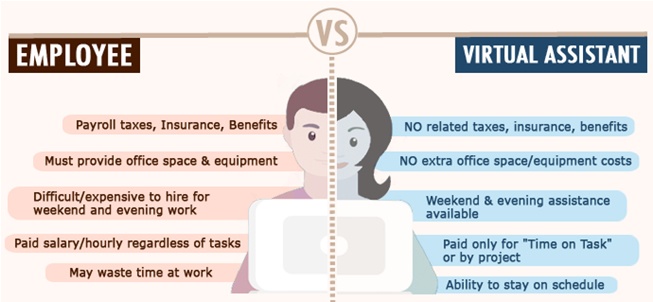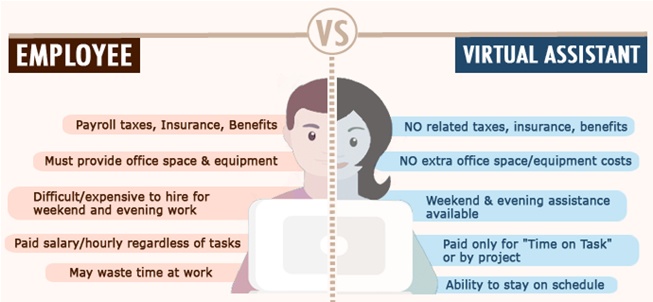The costs of hiring an in-house employee often outweigh the benefits. They can deter businesses from hiring new employees despite increased business growth. Even when current staff is begging for more help, a business may not want to bring on an in-house employee if it means taking a hefty financial hit.
When a business loses a salaried employee, the business must pony up the hard costs for:
- Advertising
- Screening
- Interviewing
- Hiring
- Training
- Benefits
- Taxes
- IT infrastructure and support
- Facility costs
- Work computer
Additionally, a business must absorb intangible costs such as reduced productivity and lost opportunity, which is why it takes 6 to 9 months’ salary on average to replace a salaried employee.
The Cost of Employee Turnover
A Center for American Progress study found that the average costs to replace an employee are:
- 16% of annual salary for high-turnover, low-paying jobs (earning under $30,000 a year). For example, the cost to replace a $10/hour retail employee would be $3,328. Other sources estimate that for entry-level employees, it costs between 30-50% of their annual salary to replace them.
- 20% of annual salary for mid-range positions (earning $30,000 to $50,000 a year). For example, the cost to replace a $40k manager would be $8,000. Other sources estimate that for mid-level employees, it costs upwards of 150% of their annual salary to replace them.
- Up to 213% of annual salary for highly educated executive positions. For example, the cost to replace a $100k CEO is $213,000. Other sources estimate that for high-level or highly specialized employees, it costs approximately 400% of their annual salary to replace them.
Ouch. Obviously, it pays to hire well and retain better.
What does it cost your business to lose an employee? Find out now using this handy calculator.
The Cost of Sales Support: In-House vs. Virtual
 image credit: Virtual Assistant Talent
image credit: Virtual Assistant Talent
Consider the above costs in association with hiring in-house sales support. Typically, a new hire for this position will be entry-level or mid-level, which means you’ll be paying between 30-150% of their salary just to bring them aboard.
How does that compare to the cost of hiring a virtual assistant? Generally, when you hire a virtual assistant, your costs will be 50-75% of what it takes to hire an in-house employee. Since virtual assistants (or the service providers that manage them) cover the costs associated with hiring, you never have to shoulder those costs. So, the risk factor is considerably less than if you were to hire an in-house employee to do the same job.
Virtual assistants who function in a sales capacity typically do so as remote sales assistants or sales development representatives who can prospect, update your CRM, manage your email inbox, schedule meetings and follow-up, make and answer calls, and more in direct support of an account executive. Since most account executives are on the road or running around, it doesn't matter where their assistant is based, which makes hiring a virtual sales assistant that much more appealing.
Onsite Management vs. Hands Off Help
Another cost that is often overlooked is the management of in-house employees. When considering an in-house employee, you must also consider that an in-house team or individual is responsible for developing and guiding the processes for employees, which can add an additional 20% to your annual in-house cost.
These costs can be offset by hiring a virtual assistant through a managed service provider who deals with:
- Recruiting: Managed service providers identify, assess, screen, and hire candidates for the role.
- Training: They ensure that their virtual assistants are experienced with the tools and processes needed to support your business.
- Personal Development: They provide feedback, development coaching, and mentorship.
- Turnover: They maintain trained backups and manage transitions.
Strategic Financial Benefits of Managed Service Providers
Using a managed service provider gives you a number of strategic benefits, with process improvements providing a significant ROI even on their own:
- Scalability: You can scale more quickly and better match costs to business needs.
- Best Practices: They leverage insights from similar clients on processes and technology solutions.
- Process Documentation: They focus on process to delegate the work. This ensures that you are documenting and improving processes that are otherwise generally de-prioritized.
- Focus: When you focus on core competencies instead of hiring support, your company remains nimble and can execute more efficiently.
What About Company Culture?
Technology has given virtual assistants the ability to redefine the ecosystem of work and the boundaries of business. Advances in tech provide the global workforce with access to remote collaboration tools for video-conferencing, group communication, and cloud-based storage tools.
These tools enhance comradery and morale rather than detracting from them. They also allow companies to tap into a greater level of workforce diversity, which has been proven to be better for company culture and better for business.
McKinsey examined proprietary data sets for 366 public companies across a range of industries in Canada, Latin America, the United Kingdom, and the United States. The findings were clear:
- Companies in the top quartile for racial and ethnic diversity are 35% more likely to have financial returns above their respective national industry medians.
- Companies in the bottom quartile both for gender and for ethnicity and race are statistically less likely to achieve above-average financial returns than the average companies in the data set (that is, bottom-quartile companies are lagging rather than merely not leading).
- In the United States, there is a linear relationship between racial and ethnic diversity and better financial performance: for every 10% increase in racial and ethnic diversity on the senior-executive team, earnings before interest and taxes (EBIT) rise 0.8%.
- Racial and ethnic diversity has a stronger impact on financial performance in the United States than gender diversity, perhaps because earlier efforts to increase women’s representation in the top levels of business have already yielded positive results.
- The unequal performance of companies in the same industry and the same country implies that diversity is a competitive differentiator shifting market share toward more diverse companies.
These facts offer valuable financial incentives to businesses, since a remote worker from a diverse background and/or locale can fill the same role as an in-house employee (e.g., build your sales pipeline) for a much more competitive price and engage in your company culture like any other remote worker, in-house or otherwise.
What about remote employees? Well, you’re still paying the costs associated with bringing someone on in-house. But the current business practice of allowing employees to work remotely as well as the practice of hiring remote, specialized contractors (virtual assistants, virtual software programmers, virtual human resource managers) has gained considerable ground over the past decade.
 “With technology, organization boundaries become more tied to shared values and goals,” says Dave Ulrich, co-founder and partner at consulting firm The RBL Group. “Work can be done anywhere, anytime, anyplace, so employees who work virtually need to share the values and commitments of their organization. Allowing employees to work virtually gives them more flexibility, autonomy, and control of their work schedule. The risks are that the employees may not feel part of a team or involved in organization culture, and make decisions in isolation. Virtual employment would work best with clearly defined roles and responsibilities where virtual employees would know what is expected of them. We have also found that virtual employees need face-to-face contact from time to time to be connected to other employees, and to feel part of the organization culture.”
“With technology, organization boundaries become more tied to shared values and goals,” says Dave Ulrich, co-founder and partner at consulting firm The RBL Group. “Work can be done anywhere, anytime, anyplace, so employees who work virtually need to share the values and commitments of their organization. Allowing employees to work virtually gives them more flexibility, autonomy, and control of their work schedule. The risks are that the employees may not feel part of a team or involved in organization culture, and make decisions in isolation. Virtual employment would work best with clearly defined roles and responsibilities where virtual employees would know what is expected of them. We have also found that virtual employees need face-to-face contact from time to time to be connected to other employees, and to feel part of the organization culture.”
When you hire virtual assistants from managed service providers, they are already an employee embedded in a company culture. So, there’s no issue with them feeling like they aren’t a part of a team. But that’s not to say they can’t be absorbed into your company culture and make positive, lasting contributions. This happens more often than not, because those who hire virtual assistants quickly view them as indispensable additions to the team, and find that their prior reservations (a.k.a. skepticism) were largely unfounded.
Even still, some businesses decide against hiring remote workers even if they have in-house employees who work remotely.
“For Citizen, we made a really conscious decision that we needed the energy of in-house employees. Having the ability to walk over and say ‘what about this?’ is huge for us. The innovation and creativity that we can bring to a project is amplified by working with people next to each other. We lose situational knowledge when contractors and freelancers walk out the door. Even if it’s an operations person, just being able to ask them questions provides an opportunity to do something better, quicker, which is possibly lost when the person isn’t there.”
Rick Watson, Director of Recruitment at Portland-based design and technology company Citizen
.webp?width=319&height=425&name=image%20(82).webp) Yet, Rick realizes that the topic of working remotely is not as black and white as it used to be. “We can work from home just as easily as we can work onsite. The amount that we work from home or a coffee shop is crazy compared to a more conventional setting twenty years ago. We take it for granted. Maybe remote collaboration isn’t such a barrier to company culture, since the gap between virtual and in-house work is likely more narrow than we realize. The flexibility that virtual assistants offer is huge. It’s the perfect marriage of technology and service, since tech is dependable and robust enough to support a virtual person to address those gaps – those naturally occurring for a really busy person. At Citizen, the most important aspect is that we establish relationships with our teams, we know the processes, know how to work together, and have intimate knowledge of the team and its members. Relationships are foundational to success.”
Yet, Rick realizes that the topic of working remotely is not as black and white as it used to be. “We can work from home just as easily as we can work onsite. The amount that we work from home or a coffee shop is crazy compared to a more conventional setting twenty years ago. We take it for granted. Maybe remote collaboration isn’t such a barrier to company culture, since the gap between virtual and in-house work is likely more narrow than we realize. The flexibility that virtual assistants offer is huge. It’s the perfect marriage of technology and service, since tech is dependable and robust enough to support a virtual person to address those gaps – those naturally occurring for a really busy person. At Citizen, the most important aspect is that we establish relationships with our teams, we know the processes, know how to work together, and have intimate knowledge of the team and its members. Relationships are foundational to success.”
The Sum of Its Parts
So it would seem that whether a business staffs salaried employees (in-house or virtual), or remote workers from either an unmanaged marketplace (Craigslist, Virtual Staff Finder) or a managed service provider (Prialto), a workforce that contributes to a healthy bottom line is a combination of financial, social, and technology-enabled collaborative factors.
Do you want to understand how to hire and onboard a virtual assistant? Here’s your go-to resource.
